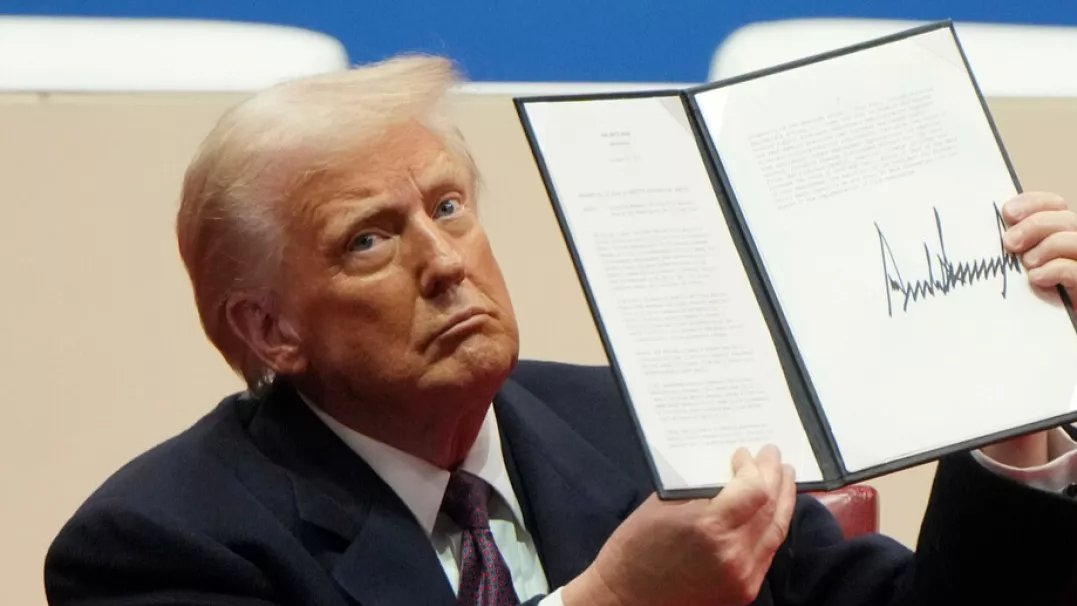
Donald Trump withdrew from a landmark climate agreement and the World Health Organisation (WHO), advanced his vision for “peace through strength”, and expressed doubt about the ceasefire between Israel and Hamas on his first day as president of the US.
In one of many executive orders he signed shortly after being inaugurated as the 47th US president on Monday, Trump pulled the country out of the Paris climate agreement — repeating a move he made during his first term that was reversed by his successor, Joe Biden.
Trump’s order said the accord is one of several international agreements and organisations that don’t reflect US values and which “steer American taxpayer dollars to countries that do not require, or merit, financial assistance in the interests of the American people” — a nod to the “America first” doctrine he first rolled out in 2017 and which he has revived for his second term.
‘Peace through strength’
At a speech during the commander-in-chief inaugural ball, Trump said the US would achieve “peace through strength,” an expression often attributed to the 40th President Ronald Reagan.
“We will measure our success not only by the battles we win, but also by the wars we end and perhaps most importantly, the wars we never get into. It’s called peace through strength,” Trump said.
Ukrainian President Volodymyr Zelenskyy acknowledged his comment in a post on social media, saying, “President Trump is always decisive, and the peace through strength policy he announced provides an opportunity to strengthen American leadership and achieve a long-term and just peace, which is the top priority.”
Details on how Trump would broker a peace deal between Russia and Ukraine, however, are scarce.
When asked during an improvised press conference at the Oval Office, Trump said he would meet Russian President Vladimir Putin “very soon” and said the Russian leader was “destroying” Russia by refusing to negotiate a ceasefire with Ukraine.
“I have to speak to President Putin, we’re gonna have to find out. He can’t be thrilled. He’s not doing so well,” Trump said, adding that Zelenskyy “wants to make a deal”.
Kyiv has repeatedly rejected any notion of a peace deal with the Kremlin that would involve relinquishing its territories, including the Russian-occupied Crimea, which was unilaterally annexed during the first invasion of Ukraine in 2014.
Israel and Hamas
When asked by a White House reporter if he thought Israel and Hamas would maintain a landmark ceasefire deal agreed upon days before Trump entered the White House, Trump said, “That’s not our war, it’s their war. But I’m not confident.”
Days earlier, Trump claimed credit for the three-phase ceasefire deal between Israel and Hamas, which was the product of months-long negotiations with the US, Qatar, and Egypt. The deal, based on one that Biden’s negotiating team put forward in May, came into effect on Sunday following delays on the Israeli side.
However, Trump has now reversed sanctions imposed by the Biden administration on extremist Israeli settler groups and individuals accused of abusing and attacking Palestinians in the occupied West Bank.
According to the Times of Israel, the order was used against 17 individuals and 16 entities over the past year, including settlers the US said had violently attacked Palestinians and illegally driven them off their land.
It is understood that Israeli Prime Minister Benjamin Netanyahu had raised the issue with Trump ahead of his inauguration.

Pause in foreign aid
In another executive order signed on Monday, Trump temporarily suspended all US foreign aid programmes for 90 days pending review, a move Secretary of State Marco Rubio had hinted at a week earlier.
It is not immediately clear how many millions of dollars would initially be impacted by the order, as Congress has already mandated the distribution of US foreign aid for many programmes and is thus compelled to spend it.
Trump’s order means that Rubio or a junior designee will determine if and where foreign aid should be spent. Rubio said last week that all funding proposals would have to answer three questions: “Does it make America safer? Does it make America stronger? Does it make America more prosperous?”
Trump has long complained about US foreign aid spending, as well as the money the US has spent assisting Ukraine as it continues to defend itself against Russia.
The last official accounting of foreign aid in the Biden administration showed $68 billion (€65 billion) was earmarked for initiatives abroad, ranging from disaster relief to health and pro-democracy initiatives in 204 countries and regions, according to AP.
Countries such as Israel, Egypt and Jordan are some of the biggest recipients of US foreign aid. They are unlikely to see dramatic reductions in what they receive, at least in the short term, as their donations are included in packages that were set up decades ago.
‘Spain is very low’
In another remark during an Oval Office press conference, Trump said when asked about NATO spending that “Spain is very low”. The country is one of three European NATO members that have yet to reach NATO’s defence spending threshold of 2% of GDP.
He then asked whether Spain was a “BRICS” nation. It is not: the alliance’s core members are in fact Brazil, Russia, India, China and South Africa, and it shares no member states with NATO or the EU.

“If the BRICS nations want to do that, that’s okay, but we are going to put at least a 100% tariff on the business they do with the United States,” Trump said nonetheless.
He has suggested that NATO should hike its threshold to 5%, a figure dramatically higher than most members’ current budgets.
Elsewhere, Trump declined to act on a campaign threat to impose sweeping tariffs on Canada and Mexico on his first day in office. Instead, he announced he would issue new tariffs on Canada on 1 February.



